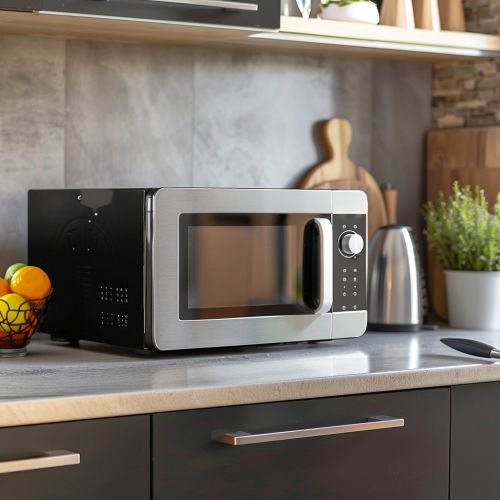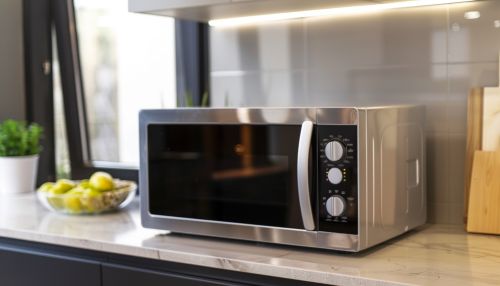Microwave Oven: Difference between revisions
No edit summary |
No edit summary |
||
| Line 26: | Line 26: | ||
The control panel allows the user to set the cooking time, power level, and other functions. Modern microwave ovens often feature digital displays, touchpad controls, and preset cooking programs. | The control panel allows the user to set the cooking time, power level, and other functions. Modern microwave ovens often feature digital displays, touchpad controls, and preset cooking programs. | ||
[[Image:Detail-79531.jpg|thumb|center|Modern microwave oven on a kitchen counter.]] | [[Image:Detail-79531.jpg|thumb|center|Modern microwave oven on a kitchen counter.|class=only_on_mobile]] | ||
[[Image:Detail-79532.jpg|thumb|center|Modern microwave oven on a kitchen counter.|class=only_on_desktop]] | |||
== Cooking Techniques == | == Cooking Techniques == | ||
Latest revision as of 18:52, 18 May 2024
Introduction
A microwave oven is a kitchen appliance that heats and cooks food by exposing it to electromagnetic radiation in the microwave frequency range. This process induces polar molecules in the food to rotate and produce thermal energy in a process known as dielectric heating. Microwave ovens are widely used for reheating previously cooked foods and cooking a variety of foods. They are also useful for rapid heating of otherwise slowly prepared cooking items, such as hot butter, fats, and chocolate.
History
The development of the microwave oven can be traced back to the accidental discovery of microwave heating by Percy Spencer, an American engineer, in 1945. While working on radar technology during World War II, Spencer noticed that a candy bar in his pocket had melted. This led him to experiment with microwaves and eventually to the development of the first microwave oven, the Radarange, which was introduced by Raytheon in 1947.
Principles of Operation
Microwave ovens operate based on the principles of electromagnetic radiation and dielectric heating. The key component of a microwave oven is the magnetron, a type of vacuum tube that generates microwaves. These microwaves are directed into the cooking chamber where they are absorbed by water, fats, and sugars in the food. This absorption causes the molecules to vibrate and generate heat, cooking the food from the inside out.
Electromagnetic Spectrum and Microwaves
Microwaves are a form of electromagnetic radiation with wavelengths ranging from one meter to one millimeter, which corresponds to frequencies between 300 MHz (0.3 GHz) and 300 GHz. Microwave ovens typically operate at a frequency of 2.45 GHz, which is within the Industrial, Scientific, and Medical (ISM) radio bands.
Components of a Microwave Oven
A microwave oven consists of several key components:
Magnetron
The magnetron is the heart of the microwave oven. It is a high-powered vacuum tube that generates microwaves by converting electrical energy into microwave radiation. The magnetron is typically located at the top of the oven cavity.
Waveguide
The waveguide is a metal conduit that directs the microwaves from the magnetron into the cooking chamber. It ensures that the microwaves are evenly distributed throughout the cavity.
Turntable
Most microwave ovens are equipped with a turntable that rotates the food to ensure even cooking. The turntable is usually made of glass and is driven by a small motor located beneath the oven cavity.
Control Panel
The control panel allows the user to set the cooking time, power level, and other functions. Modern microwave ovens often feature digital displays, touchpad controls, and preset cooking programs.


Cooking Techniques
Microwave ovens can be used for a variety of cooking techniques, including:
Reheating
One of the most common uses of a microwave oven is reheating previously cooked food. Microwaves are particularly effective for this purpose because they can heat food quickly and evenly.
Defrosting
Microwave ovens can also be used to defrost frozen food. Most modern microwaves have a defrost setting that uses a lower power level to thaw food without cooking it.
Cooking
Microwave ovens can be used to cook a wide range of foods, from vegetables and grains to meats and baked goods. Cooking times and techniques vary depending on the type of food and the desired outcome.
Safety Considerations
While microwave ovens are generally safe to use, there are several important safety considerations to keep in mind:
Metal Objects
Metal objects should not be placed in a microwave oven, as they can cause arcing and potentially damage the appliance. This includes aluminum foil, metal utensils, and certain types of cookware.
Superheating
Superheating occurs when water or other liquids are heated beyond their boiling point without actually boiling. This can result in sudden and violent boiling when the liquid is disturbed. To prevent superheating, it is recommended to place a non-metallic object, such as a wooden stick, in the container while heating.
Microwave Leakage
Microwave ovens are designed to contain the microwaves within the cooking chamber. However, it is important to ensure that the door seals are intact and that the oven is in good working condition to prevent microwave leakage.
Advances in Microwave Technology
Over the years, microwave oven technology has advanced significantly. Some of the notable developments include:
Inverter Technology
Inverter technology allows for more precise control of the microwave's power output. This results in more even cooking and better preservation of food texture and nutrients.
Convection Microwaves
Convection microwave ovens combine microwave cooking with convection heating. This allows for browning, crisping, and baking, making them more versatile than standard microwave ovens.
Smart Microwaves
Smart microwaves are equipped with Wi-Fi connectivity and can be controlled remotely via smartphone apps. They often feature advanced cooking algorithms and can be integrated with other smart home devices.
Environmental Impact
Microwave ovens have both positive and negative environmental impacts. On the positive side, they are energy-efficient compared to conventional ovens, as they cook food faster and use less energy. However, the production and disposal of microwave ovens contribute to electronic waste and environmental pollution.
Conclusion
The microwave oven is a versatile and indispensable kitchen appliance that has revolutionized the way we cook and reheat food. Its development and evolution have been driven by advances in technology and a better understanding of electromagnetic radiation. As microwave technology continues to evolve, we can expect even more innovative and efficient cooking solutions in the future.
